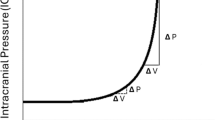Abstract
During evolution of the surgical procedure to implant ventriculojugular (VJ) shunts against the direction of blood flow for the treatment of hydrocephalus, various modifications were made in the shunting catheter and in the implantation technique with the aim of improving the results. Shunt implantation was difficult in infants and young children with compressible craniums and the modifications failed to improve the results. Accordingly, they were not considered suitable for this method of cerebrospinal fluid (CSF) shunting. Our present policy is to implant VJ shunts in hydrocephalic patients with rigid craniums and ventriculoperitoneal (VP) shunts in infants and young children to tide them over a period until they become suitable for VJ shunting. During the past 5 years, 110 hydrocephalic patients with rigid craniums were treated by implanting VJ shunts without need for further modifications. The shunt was revised in one patient during the early postoperative period due to CSF leakage under the scalp. There were no complications related to CSF overdrainage in any of the cases.
Similar content being viewed by others
References
Davson H (1967) The cerebrospinal fluid pressure. In: Davson H (ed) Physiology of the cerebrospinal fluid. Churchill Livingstone, London, pp 337–382
El-Shafei IL (1985) Ventriculovenous shunt against the direction of blood flow: a new approach for shunting the cerebrospinal fluid to the venous circulation. Child's Nerv Syst 1:200–207
El-Shafei IL (1987) Ventriculojugular shunt against the direction of blood flow. I. Role of the internal jugular vein as an antisiphonage device. Child's Nerv Syst 3:282–284
El-Shafei IL (1987) Ventriculojugular shunt against the direction of blood flow. II. Theoretical and experimental basis for shunting the cerebrospinal fluid against the direction of blood flow. Child's Nerv Syst 3:285–291
El-Shafei IL (1987) Ventriculojugular shunt against the direction of blood flow. III. Operative technique and results. Child's Nerv Syst 3:342–349
Foltz EL (1966) The first seven years of a hydrocephalus project. In: Schulman K (ed) Workshop in hydrocephalus. University of Pennsylvania Press, Pittsburgh
Hafez M (1989) Treatment of hydrocephalus: a new shunting technique. MD thesis, Cairo University Press
Ingraham FD, Matson DD, Alexander E Jr, Woods RP (1948) Studies in the treatment of experimental hydrocephalus. J Neuropathol Exp Neurol 7:123–143
Milhorat TH (1972) Hydrocephalus and the cerebrospinal fluid. Williams & Wilkins, Baltimore
Noordergraaf AL (1978) Circulatory system dynamics, chap 5. Academic Press, New York London
Pudenz RH, Russel FE, Hurd AH, Cheldon CH (1957) Ventriculo-auriculostomy. A technique for shunting cerebrospinal fluid into the right auricle. Preliminary report. J Neurosurg 14:171–179
Author information
Authors and Affiliations
Rights and permissions
About this article
Cite this article
El-Shafei, I., Hafez, M.A. Ventriculojugular shunt against the direction of blood flow. Child's Nerv Syst 7, 197–204 (1991). https://doi.org/10.1007/BF00249395
Received:
Issue Date:
DOI: https://doi.org/10.1007/BF00249395




